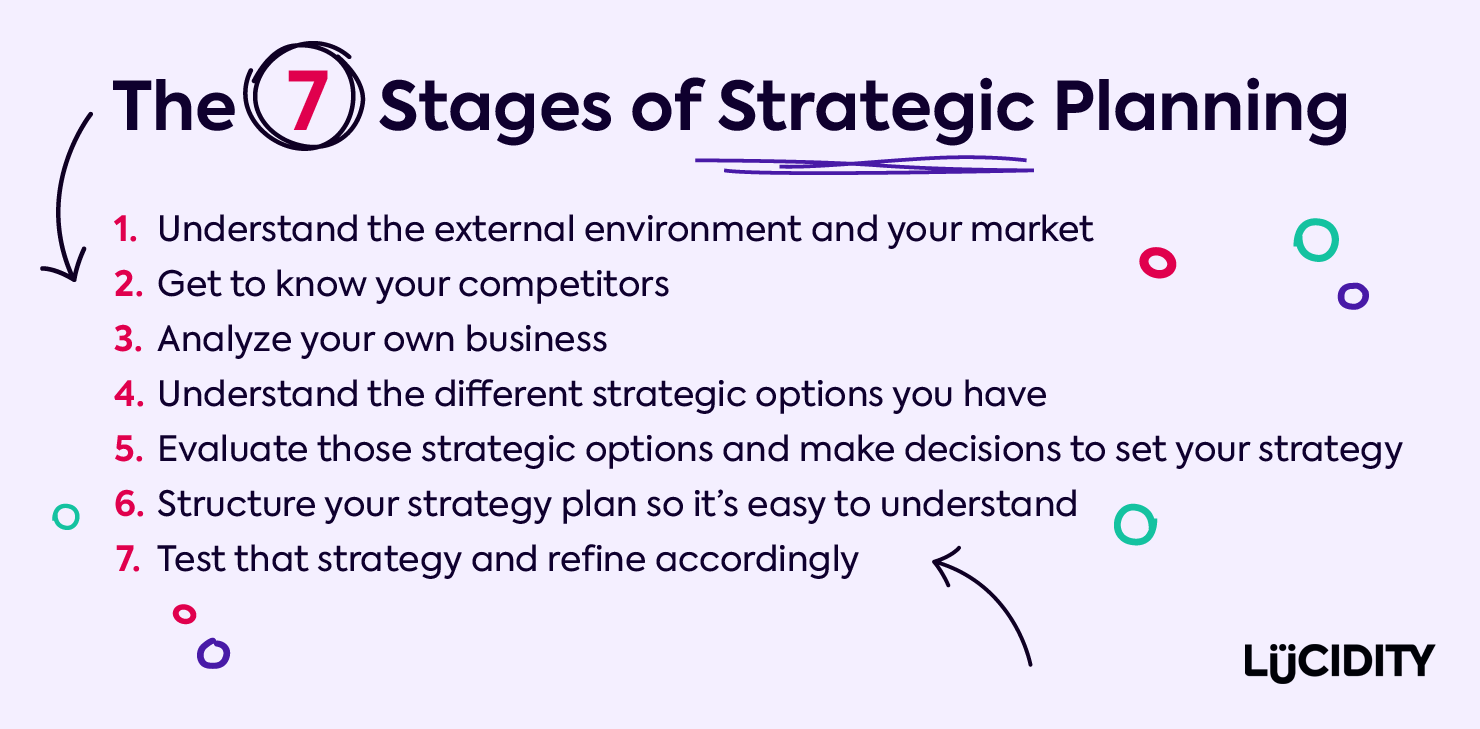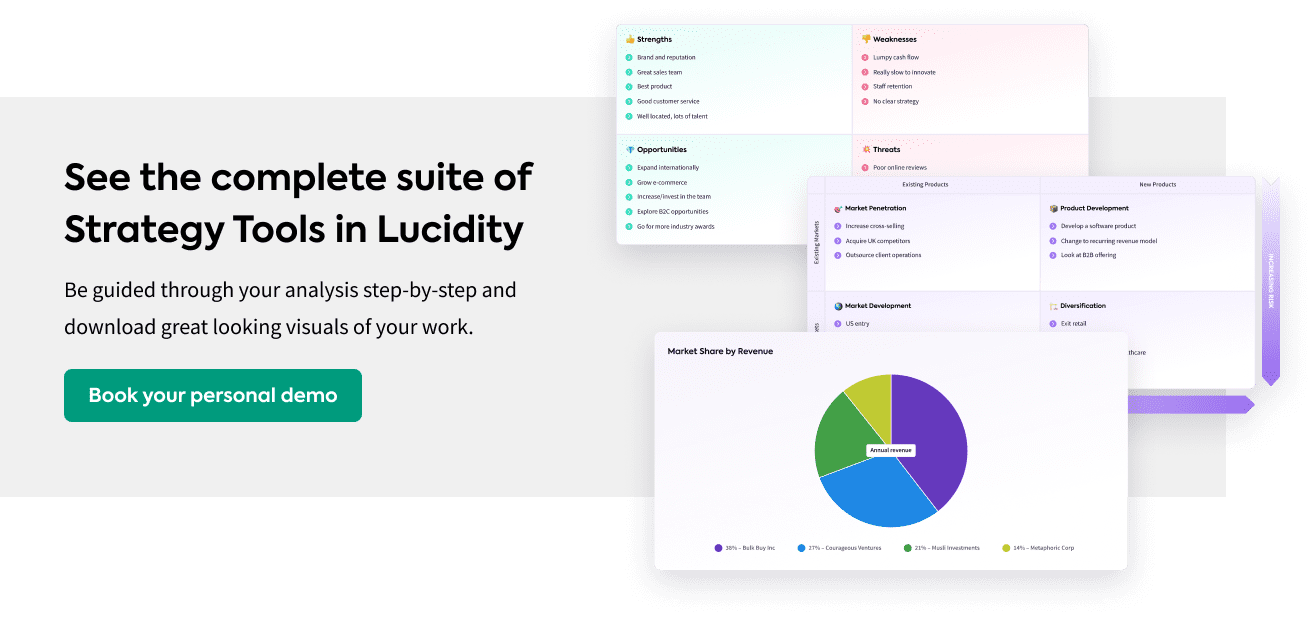Business text books are rammed full of different strategy tools, models and frameworks to help you do some analysis and get the insight you need to work out what to do to grow your business. But there are hundreds of them! Where on earth should you start, and what do they all do?
In the second in our Strategy Tools series, we’re looking at the tools and models that will help you understand all of the different strategic options that are available to you. After all, how can you decide which strategy is best for your business if you don’t know what each possible strategic direction could be?
The 7 Stages of Strategic Planning
In order to get a grasp of all these strategy tools and work out which ones will help you get the answers you need, it’s helpful to look at them in the context of the overall process of devising a strategy plan.
So, we’ve broken the process down into 7 clear steps and then listed the specific strategy tools that can help you at each stage.
In the first of our definitive lists of Strategy Tools, we looked at the frameworks, tools and models that constitute the best starting place in terms of your strategic planning. Those were the tools that help you to understand the wider external environment, your own market and competitors, and finally examine and assess the strengths and weaknesses of your own business (stages 1 – 3 of the process).
So, if you haven’t done any of that work, take a quick look at our Best Strategy Tools to Analyze Your Market & Business before we move onto the next stage of your strategy planning.
So, let’s look at stages 4 and 5 of your strategic planning work – to understand the different options there are for setting a strategy and direction for your business, and then to evaluate them and make some decisions.
Using These Tools
We’ve said it before, but getting as many people together as possible and working through these tools as a team always gives the best results. If you have a range of different people in the group, with different experiences, skills and outlooks, you’re bound to capture a lot more insight and ideas.
Using the tools in a workshop environment does help to bring them to life for people and make the process enjoyable. It’s crucial that you come away from the distractions of the daily to-do list and enable everyone to focus on the bigger picture.
Traditionally teams use flip charts and whiteboards to do these tools in a workshop environment, but certainly here at Lucidity we think you can you can do better than that! In our software you’ll find a whole suite of interactive strategy tools that you work through step-by-step. You can do these altogether on screen meaning you can have a great workshop session whether you’re altogether in a room or joining remotely.
Using the strategy tools in Lucidity also means everything is effortlessly saved and kept together in one easily accessible central home. You’ll also get great looking visuals of each tool you complete, ready to download and share with the wider business.
Tools to Understand the Different Strategic Options
Armed with a solid understanding of the environment you’re operating in, the competitive landscape and your own strengths and weaknesses as a business (having worked through these tools), it’s time to think about the different strategic options and positions you could take. Here are our favourite tools for the job.
Ansoff Matrix
Alongside SWOT, the Ansoff Matrix is probably one of the most widely recognised strategy tools. It’s a 2 x 2 matrix (yes, another one), that classifies four different strategic options. Each is a different possible approach to a market. They are Market Penetration, where you focus on growing your share of your current market with more sales of your current product or service; Product Development, where you’re focused on new products for your existing market; Market Development, where you’re looking to take your existing products to new markets; and finally Diversification, where you’re going for new markets and new products/services. The Ansoff tool also helps you see the level of risk associated with each strategic option.
Value Disciplines Model
This strategy tool lays out three areas of focus. Its claim is that, for a business to succeed, they must be good in all three areas, but give extra focus and attention to one and become excellent in that. This tool helps you consider different strategic options by making you focus down on three specific aspects of your business and choosing one to focus your strategy around. Those areas are Product Leadership, Operational Excellence and Customer Intimacy. This is a great model for helping businesses focus and build a strategy with a firm and consistent motivation.
Bowman’s Strategy Clock
Another tool to help you understand the different possible strategic positions is Bowman’s Strategy Clock. This time the different strategies are based on price and perceived value. The clock has 8 different positions on it, each with a different profile in terms of price and value to the customer – from low price and low value, through low price and high value, to high price and high value. Each different position has a specific strategy name, including strategies like ‘Focused Differentiation’, where you provide high value at a high price; ‘Low Price’, where you’re aiming to be the lowest cost option; and ‘Hybrid’, where you’re trying to offer a low price at the same time as promoting the value you offer.
Porter’s Generic Strategies
Michael Porter created his Generic Strategies tool to help classify four common strategic approaches companies can take in the market. Those four strategies are Cost Leadership (all about reducing costs to drive profit), Cost Focus (a similar approach to lowing costs but this time specializing in a niche market), Differentiation Leadership (where you focus on the uniqueness of your product or service) and Differentiation Focus (having a well differentiated offering in a niche market). Understanding each of these strategies will help you assess where you are today and help you think about where you want to be in the future.
Grand Strategy Matrix
Very much the new kid on the strategy tool block, the Grand Strategy Matrix has four quadrants each with a list of different strategic options to consider. The quadrants are created across two dimensions – market growth (from rapid to slow) and competitive position (from weak to strong). Depending on where you feel your business falls across these two dimensions, you will be presented with a list of the strategic options most appropriate to you. It’s a great tool to help you narrow down the list of possible strategies and just consider those that are suitable to your circumstances.
Miles & Snow Organizational Strategies
Another good tool to help understand the different strategic positions you could take comes from Miles and Snow. They have outlined four different positions that businesses can use to both articulate their current position and describe their future ambitions. Those four strategies are Defender, Prospector, Analyzer and Reactor. They define different behaviours and approaches to growth for each strategic position.
GE Matrix
The GE Matrix is similar to both the BCG Growth-Share Matrix and the ADL Matrix mentioned in our first Strategy Tools list , in that it’s also a strategy tool to help you classify your different products or services. Arguably we could have included this tool in our list to use when analysing your business, but we’ve put it here because it does have slightly more of a focus on actions. The tool helps you decide what strategic decisions to take for each product/service based on where you position it on this 3 x 3 grid. The tool shows you where to ‘grow’, ‘hold’ or ‘harvest’ a product/service based on how strong the business unit is and how attractive the market is. This tool will help you make strategic decisions about where to focus attention and put resource.
TOWS
Now, those of you who are really paying attention may spot that TOWS is SWOT backwards. But we promise this isn’t us bulking out our lists with double entries! TOWS is a different tool to SWOT. And the reason we’ve listed it here in this list on strategic options and making decisions, is that it’s all about actions. TOWS takes your SWOT Analysis and helps you turn that insight into some decisions on what you should do. The tool helps you see the relationship between each section of the SWOT so you can see the impact, say your strengths have on your opportunities and your threats have on your weaknesses. It helps you see what specific actions you need to take to eliminate threats by combating your weaknesses and/or leveraging your strengths, and how to capitalise on opportunities by exploiting your strengths.
The Absolute Best Tool to Assess Those Options and Make a Decision 🙌
SFA Matrix
Whether you use one, two or all of the above tools to help you see the different strategic options you have, we highly recommend that you always use the SFA Matrix tool to help you then evaluate those different strategic options and see which is the most likely to be effective for your business. With SFA you are assessing each option against the criteria of Suitability, Feasibility and Acceptability. Using a table, you list out each option you are considering and score them against each criterion (out of 10). You’ll then easily be able to see which option is most suited to your business by which has the highest score. Simples.
Tools to Evaluate Diversification Options
There are a number of tools that are specifically concerned with choosing the right path when diversifying your business. Here are some of our favourites.
The Ansoff Matrix….again
This is the second appearance of the Ansoff on our list. Take a look above for a fuller explanation of this tool, but it’s certainly one for your list if you’re thinking about new markets or products, or both!
CAGE Distance Framework
This strategy tool is specifically looking at geographic expansion or diversification. So, if you’re considering moving into new geographies then this tool will help you capture all the differences and considerations you’ll need to address in order to do so. It will help you list out the unique elements of the new market and then the measures you’ll need to take as a business to respond to those.
Porter’s Three Tests
Once you have some specific ideas about how you might diversify your business, this strategy tool will help you assess those options and find the one that is most likely to succeed. With this tool you are asking three questions of each option – how attractive is the new market? How much will it cost to enter that market? And what benefits will that market bring to the business? These are simple questions that really help to challenge your thinking and interrogate your diversification ideas.
Now What?
Whichever tool or tools you’ve chosen from this list, you should come away with a solid understanding of the different strategic options and be able to make a strong decision on which is most suited to your business and ambitions.
Now you’re ready to turn that insight and decision into a plan of action. Look out for our next list of recommended tools to help you structure and communicate a strategy plan– it’s coming soon!













